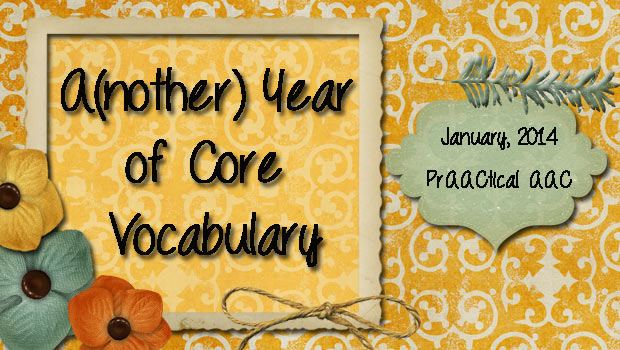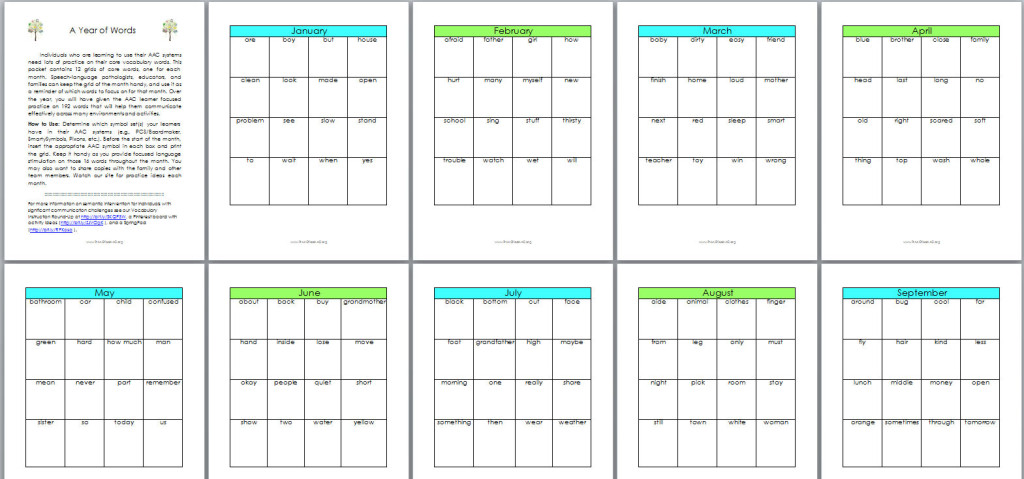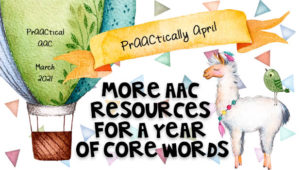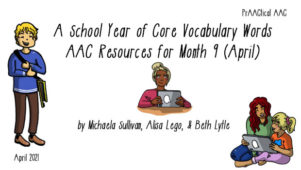A(nother) Year of Core Vocabulary

It hardly seems possible that a year has gone by since we posted a Year of Core Words 2013. We’ve been so gratified by the feedback from professionals and parents who’ve put it to good use and followed month-by-month to focus on a dozen core words and get suggestions for additional practice. We were thrilled when others added symbols, created teaching materials, and adapted it for their own use.
Today we’re back with the 2nd Year of Core Words, this time with 16 words/month. If you follow along, you’ll have covered 192 new core words by the end.
Once again, we created 12 grids of core vocabulary words – one for each month of the year. Each grid has 16 cells labeled with core words. Plug in the AAC symbols that your client uses (e.g., PCS, SmartySymbols, Unity, Pixons, etc.), print, laminate, and keep them handy. Feel free to adapt the grids with other core words, if you wish, or do anything else that makes them more useful in your work. Then, post the grid of the month where you will see it.
Here’s the the plan for using these grids to build prAACtical skills…
-
Use aided language input and model these words for the learners using their AAC systems.
-
Elicit these 16 words in everyday routines.
-
Develop practice activities, like hiding the symbols in a sensory tub or playing Lotto.
-
Look for them in songs and chants. Highlight them and pause expectantly to get the AAC learner to say them.
-
Send them home to families so they can see what your focus is and extend the learning.
-
Share them with other professionals on the team. The power behind a core vocabulary approach is that these words are as appropriate in speech as they are in PT, reading group, music therapy, or community-based instruction.
-
Don’t leave the paraprofessionals out of the mix. If we nurture those relationships and build their skills over time, they can be our biggest allies. When you consider how much time they spend with our AAC friends, it’s clear that they have the potential for enormous impact.
-
Give a set to the learner, too. Don’t we all do best when we know what is expected of us?
-
Use the core words in writing. Jot some notes to the AAC learner once in awhile. As he/she reads the note, ask him/her to stop when they see a core word and say it out loud. Or, have them listen to you read it and they can stop you when they hear a core word. Then use the AAC system to say the core word aloud.
-
Keep track of how often you hear the core words, and make your score sheet visible to everyone on a bulletin board or clip board. A little competition could spice things up for some AAC learners.
Wishing all of you a good Year of Core Vocabulary.
::::::::::::::::::::::::::::::::::::::::::::::::::::::::::::::::::::::::::::::::::::::::::::::::::::
P.S. If you do adapt these or make teaching materials, we’d love it if you would drop us a line.
Filed under: PrAACtical Thinking
Tagged With: core vocabulary, Year of Core Words
This post was written by Carole Zangari






8 Comments
Thank you so much for your great vocabulary resources! My school district jumped into using Proloquo2go on ipads for nonverbal autistics students without any training for staff, so I am trying to teach myself. One question – do you recommend using Proloquo’s “basic communication” vocab set for emerging communicators, or using fewer choices with a “core vocabulary” focus? Thanks
Thanks for your comment, Geni! Every learner’s needs are different, but for most symbolic communicators who are using SGDs/mobile devices, we tend to go with a core vocabulary screen that has room to grow. Starting with a screen that has only a dozen or so words can be problematic once we are ready to increase the number of words. We try to plan with the end in sight whenever possible. Your students are lucky to have someone who is willing to learn these new technologies. We are actually working on a post about the need to put staff (and family) training into the IEPs for these kids. If the agency isn’t willing to support training for the equipment/software/apps they purchase, then they should be prepared for those things to be underutilized and abandoned. Staff/family training should have a significant presence in the IEPs of kids who are learning AAC. Without trained therapists/teachers/families, we put a ceiling on their ability to make progress. Don’t take this personally, Geni. It’s just that this is a topic that has been bugging us lately. Too often, they expect us to be omnipotent superheroes!
Thanks for the advice on Core Vocabulary. At least in my district there is a real lack of time and resources for AAC training. Part of the reason may be that administrators have so little knowledge of AAC that they have no idea how complex it is, so they don’t understand the need for training. Even special education teachers are often unaware of what can be accomplished with AAC. Another area where SLPs need to be advocates. Your website has been a great resource for me and I appreciate all the work you put into it.
Thanks, another great post. At east in some of your districts they even mention AAC! Anyways, I’m on my own here trying to implement at home. (My son is 6, experience Doan Syndrome. )
Anyway I was thinking of using this monthly list. Do you think I should start by programing his App (go talk now) with the first 16 words and just working on them… The other thing is the problem with Go Talk is that there is a Maximum of 25 words per page… perhaps i should ditch it, not cheap and get an app that can have many more words per page…such as Speak for yourself or…..
Thanks for listening!!!
liz tree
Thank you Dr.Z on the core vocabulry posts. One of my favorite post and very much needed.
Orin
Thanks, Orin! I was just thinking about you today. 🙂 Hope all is well.
Hi, I have been using the Basic Communication on the Proloquo2Go for some time now mostly for the student’s requests and comments. I would like to use a board that includes core words. I have read a number of your posts and quite honestly am overwhelmed with the information. I love the idea but not quite sure where to start. Do I start with a few words and position them on the board so that others can be added later? I know I have read that changing the words around a lot is confusing to the student. If there is a particular post or posts that would be most helpful, I would appreciate the input. Thank you so much.
Start with the buttons at the final size, but only a few buttons actually visible. Leave large blank spaces where the rest of the buttons will be. A lot of AAC systems allow you to hide words without moving around the rest of the words. An example of what a beginner version of a more advanced board might look like can be found here:
http://praacticalaac.org/strategy/the-first-12-getting-started-with-core-words/
Since you’re moving from a system the child has already learned, it might also be useful to edit the Core board to be similar to the Basic board. It won’t be exactly the same, but you might be able to put some familiar buttons in roughly the same general area, and have the buttons under the same category folders. I haven’t used Proloquo myself, so I don’t know how easy that would be, but if you can do that it could help the transition.